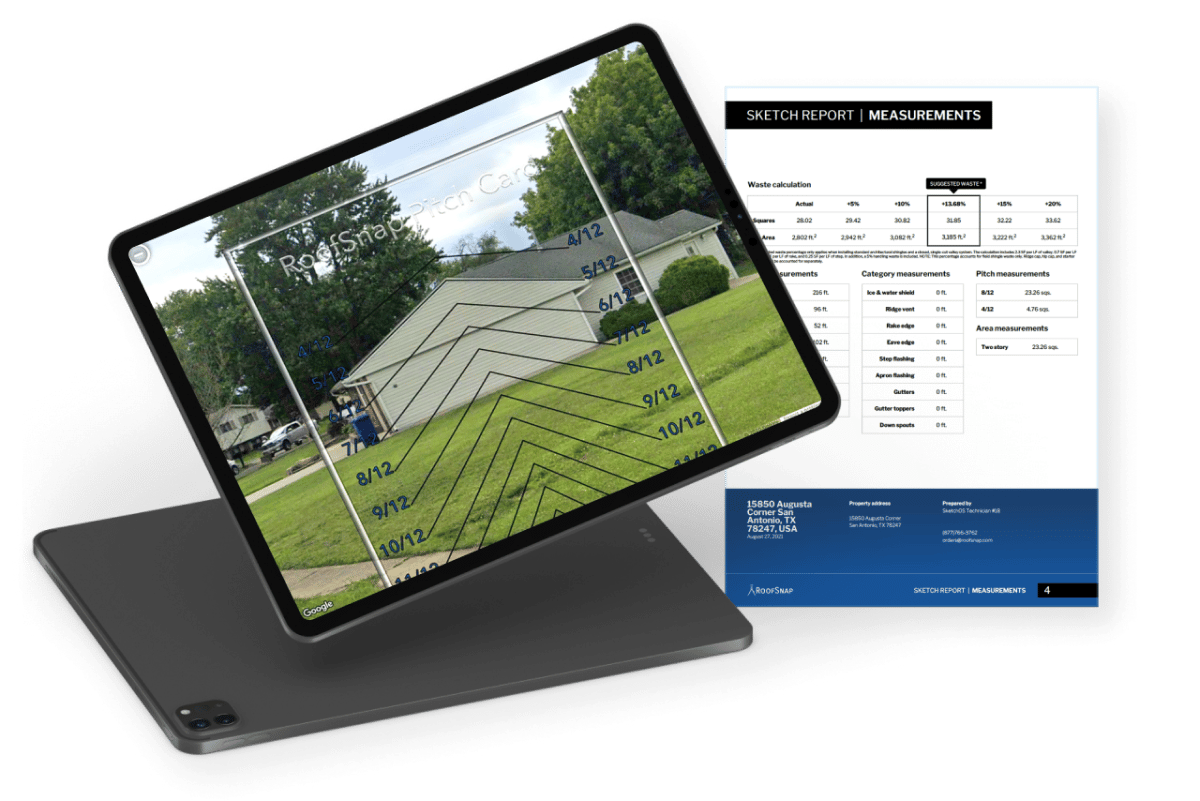Get your roof pitch perfect!

By RoofSnap.
Tips and tricks for accurate roof pitch measurements.
Planning a roofing project? Accurate roof pitch measurement is key to success. Explore different methods of determining roof pitch, from manual calculations to advanced mobile apps and tools below.
How to determine roof pitch
The roof’s pitch is the angle at which a roof rises from its lowest to highest points, generally shown by the inches of vertical "rise" over 12 inches of horizontal "run."
Measure the rise and run of your roof and use a calculator or roofing software (such as RoofSnap) to calculate the pitch in ratios or degrees, simplifying the task and setting yourself up for accuracy. Accurately measuring roof pitch is crucial for any roofing project because it determines the type and quantity of materials needed and plays a role in long-term roof performance.
How to calculate roof pitch in a ratio
Traditionally, you display roof pitch as ratio of x:12. To calculate this, you need to measure how many inches a roof rises vertically for every 12 inches of horizontal length.
You can also measure the total rise (height of the roof peak) and run (width of the roof) of the building and use a little extra math to find the pitch.
- Step 1 - Gather a level (that is 12” or longer) and a tape measure to measure the roof’s rise for a 12” run. You can do this from the roof or attic.
- Step 2 - Hold the level steady against either the roof or a rafter. Measure the height from the roof or rafter to the level 12 inches away from where it meets the surface. This measurement will be your rise.
- Step 3 - Display this measurement as a ratio of rise over run. For example, if your roof rises 4 inches over a run of 12 inches, then it has a roof pitch of 4:12.
How to calculate roof pitch in degrees
When you examine materials related to roofing, you may find references to roof pitch as a ratio or in degrees, but not necessarily both. It’s usually one or the other; the convention varies based on where in the world you are. It’s valuable to know how to convert measurements so you can always adapt.
To calculate roof pitch in degrees, you’ll need the same measurements: rise and run. Then, you will need to calculate the arctangent of the (rise/run).
- Step 1 - Follow the same steps to calculate the rise as above. The run will be 12 inches.
- Step 2 - Divide the rise by the run. If we use the same example as above, where the rise is 4 and the run is 12, then (4/12) = 0.3333333333
- Step 3 - Use a scientific calculator to find the arctangent of the rise divided by the run. This is your roof pitch in degrees (round to two decimal points). Arctan (.3333333333) = 18.43

How to find roof pitch with mobile apps and tools
When it comes time to measure pitch, you can use physical or digital tools to get the job done. If you want to go the manual route, there are a variety of pitch tools and levels on the market you can use to measure the pitch of a roof (without needing to break out the pitch calculator!)
If you want to explore more advanced technology, there are a number of mobile app options out there. It’s important you are using the app correctly, so make sure you follow the app’s usage instructions. Otherwise, you are setting yourself up for inaccurate results!
Place your mobile device on a flat surface, directly on the roof or against the fascia. (For more details, check out our guide to using pitch finder apps.)
There are even ways to accurately measure roof pitch remotely using aerial and street view imagery. With RoofSnap, you can use our virtual pitch card in order to determine the pitch — without even being onsite! You can see the project in 3D and RoofSnap does all the math for you.

How to include roof pitch in your measurements
Roof pitch brings complexity to your roof measurements. If you look at a typical roof diagram — top-down, two-dimensional — it can look pretty simple. It’s only when you add the pitch value to the diagram that it reflects the three-dimensional aspect of the roof and gives you accurate measurements.
Without a pitch value on a two-dimensional diagram, you’re missing out on the increase the pitch brings to your hips, rakes, step walls and valleys, as well as the material you’ll need to cover those lines.
Many modern residential homes have roofs with multiple pitch values and roof features like dormers or Dutch gables can complicate matters further. For reliable accurate measurements that you can confidently order materials from, it’s best to measure every roof plane’s pitch.
Having accurate roof pitch measurements is a key factor when determining the amount of roofing materials needed and the type of roofing material to use.
Original article source: RoofSnap
Learn more about RoofSnap in their Coffee Shop Directory or visit www.roofsnap.com.






















Comments
Leave a Reply
Have an account? Login to leave a comment!
Sign In